Home heating is now
the #1 cause of residential fires.
| |
Please take a few minutes
to review this material.
In less time than
that takes,
a stove or chimney
fire
could completely
change
your home
or your life.
|
Go To Chimney and
Stove Fires, Info (below)
Go To What To Do if a Chimney
or Stove Fire Happens (below)
Go To Home Fire Warning Systems: Smoke Alarms
& Detectors (below)
WOODBURNING SEASON REMINDER:
Schedule an actual date on your calendar, before
using your stove(s) or fireplace in the fall, to clean your stovepipes
or stacks. Stovepipes and chimney flues should be inspected and cleaned
each season, before using your woodstove or fireplace.
Creosote
is a sticky, powdery, shiny, brittle
and hard-glazed substance, dark brown or black with an unpleasant
odor, resulting from the condensed wood gases and liquids
of unburned fuel.
It forms highly combustible deposits
that coat the inside walls of chimneys and woodstoves. The
more it accumulates, the greater its potential fuel will be
when it ignites.
Creosote build-up is a time bomb waiting
to happen, and can add significant fuel to a fire situation.
|
How do you determine creosote build-up?
Check your stovepipe by tapping the pipe with a screwdriver:
it will "ping" if it is clean. If it "thumps,"
it needs to be cleaned. The more creosote, the duller the thump, and
the closer you are to a stovepipe fire. If creosote is building up
excessively, signs include drips out of the joints, a dull sound if
the connector is tapped, and blockage of the chimney and loss of draft,
evidenced by smoking. Large accumulations should be removed mechanically,
because the excessive amount of fuel deposited in the chimney or flue
could be damaging even if the fire is carefully controlled.
Signs of wear and tear:
Check for cracked or warped metal liners, corrosion,
rust, broken or missing bricks, bent metal chimney pipes, thin spots
and wear in the firebox and stovepipe, creosote deposits, bird nests,
and other foreign material. Clean the stovepipe or flue thoroughly,
and make any necessary repairs. Be sure that any pipe sections you've
taken apart are re-secured, and wire screens or screened stovepipe
caps are replaced firmly. Any damaged pipes, fittings, loose mortar,
worn cement or cracking should be attended to.
When choosing a new stove:
Stoves built of cast iron or sturdy steel plate are
preferred over those made of lightweight, thin-gauged materials. A
stove too large for the intended area may not be able to burn hot
for 15-30 minutes each day, which will increase the probability of
increased creosote accumulation. Seasoning or breaking in a new stove
should be done with care and patience. Follow the manufacturer's or
dealer's instructions. Some stoves, especially those of cast iron,
may require up to a total of 24 hours of low-heat fires to condition
the metal.
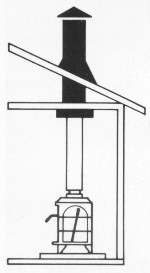 |
Safe stove & fireplace installation:
Make sure your heating appliance is installed correctly. Oregon
State law requires a permit to be obtained for the installation
of any solid fuel-burning appliance. Obtaining a permit is in
the best interest of the homeowner, since the accompanying inspection
assures that the installation is done properly.
An illegal or improper installation could affect fire insurance
coverage and the ability to obtain financing when the property
is to be sold. There have been instances in which installations
done by contractors have not been done properly. Be certain
that your installer obtains a permit so that the completed work
is inspected and approved.
A metal tag on the appliance indicates whether it is listed.
A listed stove has been certified by an approved testing agency
and has complied with nationally recognized safety standards.
The stove must be installed according to the manufacturer's
instructions. Unlisted stoves must be installed in accordance
with local building codes. |
Placement & Location of Heating Appliances:
A stove or fireplace should sit on a non-combustible surface,
usually asbestos or firebrick, with adequate clearance on all
sides from anything that can ignite. The proper distance is
a minimum of 18 inches from combustible walls or other flammable
material.
Heat radiating from a stove to a combustible wall is a common
cause of house fires. Heat causes a "baking" effect
on wood inside the wall, which reduces the ignition temperature
at which a fire may easily start.
Suitable heat barriers can reduce required stove clearance
from the wall, and guard against overheating of the surrounding
area. Stove joints should be secured with at least three screws,
and installed so that upper sections fit into lower sections. |
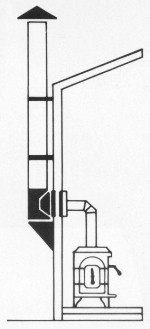 |
Cleaning:
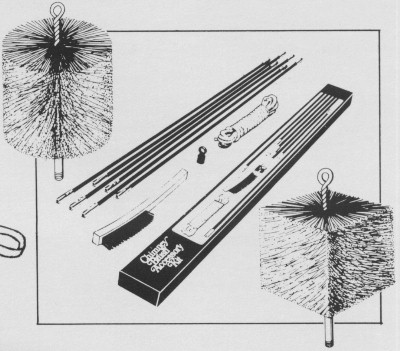
Properly sized chimney brushes should be used
to clean a chimney flue: use two brushes, one
to fit the reduced size of the flue, caused by creosote deposits,
and a second one to fit the actual chimney.
An industrial vacuum cleaner may be needed
to control ashes and soot. (Furniture should be protected with
drop cloths). |
If you plan to use an airtight woodstove every
day, clean the stovepipe once a month.
Twice a year is the recommended minimum for all other stoves
and for chimneys.
Specialized tools are required to properly clean your
stovepipe and chimney.
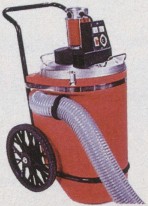
|
Hire it out?
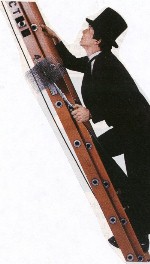
|
If your roof is precarious or you don't like
heights or getting sooty, hiring this job out might be preferable.
Professional cleaners have the experience and the tools: the
ladder, industrial-strength shop vacuum, brushes with extensions,
and dropcloths that you'll need - and they dispose of the soot
and creosote.
They should check pipe interiors, screens, fittings and joints,
as well as evaluate the overall condition of your burning unit,
and inform you of the results.
If you need assistance, we cannot endorse but can suggest that
you contact one of the following locally listed businesses:
Busy Bee Chimney Sweep: (541) 734-4348
Chim Chiminey Sweepers: (541) 734-9544
Smokey’s Stove & Spas: (541) 734-0044
Southern Oregon Power Vac: (541) 773-3525
Holy Smoke (Tony Dietz): (530) 465-2308
Chimney Doctor: (530) 938-2552
If you handle your own cleaning, care while on a ladder and
on a roof is advised. An additional person to hold the ladder
steady, hand tools so you don't have to lean down for them,
or just to help get things cleaned up later and to be sure you've
come down off the roof safely, is also advised. If you need
to borrow tools or a ladder, the Fire District may be able to
assist. Give us a call if you have any questions. |
How does creosote occur? When wood
burns, the combustion process is never absolutely complete. The smoke
that results from incomplete burning contains creosote. When the stovepipe
and/or chimney flue temperature drops below 250 degrees F., creosote
will condense on its interior surfaces. At very low temperatures (below
150 degrees F.), the creosote deposits are quite fluid. If this condition
is allowed to continue, they can become very hard, glass-like in appearance,
and difficult to deal with when a cleaning is needed.
The amount of creosote that will condense out of the
smoke depends on several factors: the species and dryness of the wood,
the density of the smoke, and the temperature of the flue. The importance
of burning seasoned wood cannot be over-emphasized.
See our firewood page for
information on wood types and fuel ratings.
Back to Top
Gaining maximum operating efficiency and limiting
creosote: The skillful stove operator tries to limit creosote
build-up because it has a corrosive effect on any metal within the
heating system. It also interferes with the draft of the chimney.
Whenever a load of wood is added to the stove, the draft
controls for combustion air should be opened for 10 to 30 minutes.
The length of time will vary according to the amount of fuel added
to the stove and the moisture content of the fuel. This procedure
will drive off some of the remaining moisture in the wood and allow
it to burn evenly. It will also raise the flue temperature and promote
a stronger draft.
It is important to regulate the amount of heat from
your stove by the size of the fire that you build. This may require
more frequent re-fueling of the appliance, but the rewards will be
more complete combustion and increased efficiency.
It is better to burn a small fire with plenty of combustion
air than to build a large fire and let it smolder for lack of oxygen.
Shutting down the oxygen supply greatly, to decrease the stove temperature,
results in an air-starved fire. An air-starved fire produces more
creosote condensation because of increased smoke density and cooler
flue temperatures.
Newer, more airtight stoves create much
more creosote than older stoves and fireplaces, and can produce
enough creosote for a fire within just three days.
|
An air-starved fire will also send large amounts of
particulate pollution into the air surrounding your home. It is wasteful,
too, because much of the volatile gas which would normally burn, were
it given enough oxygen, is simply exhausted up the chimney along with
its heat value.
Small fires with plenty of oxygen burn cleanest. Start
out small and add fuel gradually, staying within a safe operating
range. Burn briskly the first 30 minutes; maintain a moderate rate
thereafter. A good rule of thumb is to get the temperature up to a
stovepipe thermometer reading of 450 degrees F. for the first half-hour,
and to keep it at an average of 300 degrees thereafter, each day that
you start your stove.
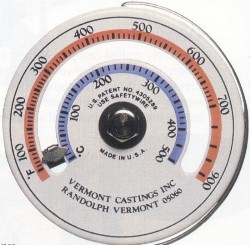 |
A magnetic stove thermometer
(as shown at left) attaches to the stove and enables you to
monitor surface temperatures. It helps you set air intakes for
appropriate combustion levels, thereby minimizing creosote accumulation.
It lets you know when it's time to reload, when to close the
damper, and warns of over-firing.
A catalytic thermometer probe looks like
a stove pipe thermometer, but is installed directly above the
combustor, and lets you know exactly when your combustor has
reached its point of maximum efficiency. A small hole must be
drilled in the cast iron to install this probe. |
A draft gauge mounts permanently on
your stove pipe, enabling you to measure your stove system's draft
continuously and accurately. The amount of draft can affect the operation
of your stove and can fluctuate with wind and temperature conditions.
Another key to limiting creosote
is to refrain from closing the damper tight at night, which
will starve the fire of the necessary oxygen for the combustion
process.
|
Back to Top
Other tips for successful stove operations:
Efficient, slow-burning stoves may not keep your chimney
or stovepipe hot enough to burn out creosote, so build a roaring hot
fire at least once a week, but do NOT over-fire.
Over-Firing: A common mistake of novice
wood burners is accidental over-firing of their woodstove. Over-firing
is visible when your appliance metal begins to glow red. This happens
when the stove is left unattended and the fire has enough oxygen to
eventually run out of control. Over-heating can be the result, and
the woodstove is likely to pay a real penalty. Over-heating may cause
steel stoves to warp and cast iron stoves to develop cracks.
Backflashing: Although uncommon, backflashing
or "back-puffing" presents some hazards, and therefore demands
mention. It occurs when the combustion chamber of the stove fills
with unburned, volatile gases. If the stove door is suddenly opened,
oxygen rushes in, mixes with these gases, and a minor explosion occurs.
It happens most often when the woodstove has been in
a very slow-burn mode (air-starved fire) for a period of time, or
when a fresh load of wood is added on top of a hot bed of coals, and
the combustion air is limited. If the stove operator is leaning down
to load wood or check the fire, he/she may get caught in a flash of
burning gases.
Prevention is easy: follow the procedure of opening
the damper, opening the draft controls for combustion air for a full
half-minute. Then open the door slowly.
Using manufactured logs or coal: Burning manufactured
"pressed logs" and coal should be done only when the stove
manufacturer has specifically approved of the practice. These types
of fuel often burn at unusually high temperatures, which may cause
damage to the appliance due to over-heating.
Trash Burning: Woodstoves are designed
for burning wood, not garbage or trash. Some types of plastic release
very toxic fumes when burned. Often the smoke and fumes from trash
can be of a poisonous and corrosive nature. Resist burning newspaper:
it is more valuable when recycled.
Fireplace tip: Don't close the damper
when the fire is still going, or when the embers are still hot: asphyxiation
from flue gases can result.
A clean spark-arrester screen over the chimney
or around the stovepipe cap provides good insurance against sparks,
which can ignite flammable material on and around the roof, or on
the ground around your home. The screen should be a wire mesh cloth
or expanded metal having approximately ½-inch (13 mm) squares.
(Ordinary, tighter mesh will quickly clog with soot, while larger
ones could allow passage of some sparks.)
 |
Stainless steel material is recommended, with
galvanized steel hardware cloth a poor second choice because
the coating soon burns off, making frequent replacement necessary.
Factory built chimney and stove manufacturers offer a variety
of chimney and stove cap options, with integral and accessory
spark arrester screens.
A metal or masonry hood over the chimney top will also reduce
wind and rain-caused backdraft and smoke problems. |
Non-combustible roofing and building
surface materials provide good insurance against fire
from sparks. (See our Community
Wildfire Protection Plan page for more recent information
about fire-safe building materials.)
The use of a protective screen (shown at right)
in front of your appliance also helps to protect your home.
Screens are relatively inexpensive, readily available, and easy
to use. |
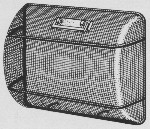 |
A common mistake is failure to securely close stove
or fireplace insert doors, allowing burning material to fall
back out and ignite the floor or other surrounding combustible
materials.
|
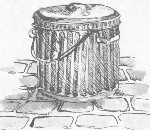 |
Ashes and Ash Removal: Many
residential fires originate from combustible containers used
for ash removal. Even "day-old" ashes can contain
deep-lying hot embers.
Ashes should always be placed in a covered metal container,
and disposed of only after you are certain that all embers are
completely out.
Never place hot ashes in a container with other flammable debris,
which can then ignite, effectively becoming a burn barrel. The
radiant heat produced can then transfer to nearby fuels or structures. |
Back to Top

CHIMNEY AND STOVE FIRES:
86% of wood heat-related fires originate in the chimney
or stove pipe, when creosote ignites. If the stove
or chimney temperature is sufficiently high, it can ignite with
just one spark.
Creosote fire temperatures range from 1,200 to 2,000
degrees F.
The temperature and duration of the fire both depend upon the
accumulated thickness of creosote, the availability of oxygen,
type of heating appliance, type of chimney or stovepipe, and
other variant factors.
A stove fire heats the pipe and stove to a
cherry-red color. It will make a loud, roaring noise that breathes
like an accelerating locomotive. It may shake loose sections
of pipe if they are not secured together properly with sheet
metal screws. Flaming clinkers may be visibly emitted out of
the top of the stovepipe.
A chimney fire can quickly heat the chimney
to over 2,000 degrees (F), warping metal, cracking masonry,
bricks, tiles, and transfer excessive heat into adjacent walls,
ceilings, or other surfaces. |
Stovepipe and Chimney Damage:
Even if the house does not catch on fire, the chimney
may need to be replaced: flue fires can break down the mortar between
bricks, allowing flames and heat to come into contact with combustibles,
and decreasing the ignition temperature of supporting framework (carbonization).
If it is suspected that an extreme chimney fire has
occurred, the liner should be visually inspected. Slight buckling
inward (¼ to ½ inch) is not cause for concern, but indicates
that temperatures may have reached the 2,000-degree F. level.
If serious damage of the chimney is seen, the affected
chimney sections should be replaced. In general, if the outer chimney
is not discolored and remains shiny, it is unlikely that any building
structural damage has occurred, since shiny surfaces are unlikely
to radiate damaging amounts of heat if the chimney is installed at
the correct clearance.
When chimney and stove fires occur in stoves and heaters
that have air dampers and doors, reducing the air supply by closing
them is the best option. Then the combustion rate in the chimney or
stove stack depends upon its air supply.
Back to Top
IF A STOVEPIPE OR CHIMNEY FIRE HAPPENS,
DO THE FOLLOWING:
1. Close the door and damper. Shut off the air supply to the
stove or fireplace. (It is optional to pour a cup of hot water on
the fire first.)
2. Call the Fire District.
3. Get everyone out of the house.
4. Hose down the roof. Avoid spraying
water down into the pipe or chimney.
5. Have the stovepipe or chimney thoroughly
cleaned and inspected before re-using.
Other Protection: A home fire warning system
Many stove and chimney fires occur as the result of
carelessness, or neglecting the fire after loading fuel. This frequently
occurs when residents have turned in for the night, leaving the fire
going. You could have a flue fire while you sleep.
Fire produces toxic gases as well as smoke that actually
numb the senses. If you're asleep, or become disoriented by toxic
gases, you may not even realize that there is a fire. You can't rely
on your own senses to detect a fire.
By the time you know about it, it could be too late
- unless you have functioning, properly located smoke detectors
- the best early warning device there is.
 |
Every year about 5,000 people die
in home fires.
Most of the deaths occur at night in homes that
do not have smoke detectors,
while people sleep. |
It is estimated that 70% of home fire deaths could
be avoided through proper installation and maintenance of smoke detectors.
In August, 2015, the NFPA (National Fire Protection
Association) gave the following statistics:
-
Three out of five home fire deaths result from
fires in properties without working smoke alarms
-
More than one-third (37 percent) of home fire
deaths result from fires in which no smoke alarms are present.
-
The risk of dying in a home fire is cut in half
in homes with working smoke alarms.
Clearly, while smoke detectors cannot provide complete
fire protection or prevent all tragedies, the universal use of these
inexpensive safety devices would save a lot of lives.
Back to Top
You can do something about this now,
to prevent a disaster such as this:
Clean your flues and chimneys
before creosote has the chance to ignite,
and install and maintain working
smoke alarms/detectors.
Back to Top
Smoke: What does it mean to your health?
Smoke from wildland fires often cause a number of people
to be adversely affected.
Some of these people, who are already vulnerable to
breathing problems caused by smoke because of previous asthma, heart
or lung conditions or because of age, become statistical cases in
local emergency wards.
What exactly is smoke? The EPA (Environmental Protection
Agency) defines it as "particulate matter air pollution."
This refers to PM10 , a particulate matter less than 10 micrometers
in diameter.
A particle this size is small enough to bypass our bodies'
natural defenses, and can cause both minor and severe health problems.
(About 100 PM 10 's would fit in the period at the end of this sentence.)
Woodstove smoke, which results from unburned fuel, also
contains significant amounts of PM 10 pollution, from carbon monoxide
(CO), carbon dioxide (CO 2), hydrocarbons, water vapor, and many other
organic compounds.
While CO 2 and H 2 O vapor are harmless, CO and PM10
are respiratory irritants, and are known to cause respiratory and
cardiovascular illness, as well as contributing to atmospheric visibility
problems and property damage.
Over time, both CO and PM 10 can be deadly. CO binds
with the hemoglobin in blood so that the blood cannot utilize oxygen.
CO is 200 times more likely to be bound to blood than oxygen. Because
blood likes to attach to CO more than oxygen, asphyxiation can occur
in the presence of oxygen.
PM 10 particles are small enough to bypass our bodies'
natural defenses. These particles lodge in lung tissue and can remain
for up to a decade. Chemicals stuck to the surface of these PM 10
particles can cause cancer or other lung ailments.
The health consequences of wildfire smoke can be avoided
by remaining indoors.
Woodstove smoke emissions outdoors are not considered
a problem, due to our usual easterly wind flow patterns and good ventilation.
Such emissions are unregulated in the Colestin valley, which is outside
of Jackson County's air quality maintenance area.
But the effects of indoor smoke pollution upon those
in close proximity to a stove that doesn't burn cleanly are insidious.
Backdraft smoke, smoke while starting the stove, and
breathing in smoke particulates while re-loading or regulating a stove
can contribute to health problems over time. This smoke can be likened
to second-hand cigarette smoke, now known to be as potentially carcinogenic
as directly inhaling cigarette smoke.
If you use a woodstove for heat, you can limit the effect
of indoor particulates, as well as outdoor pollution, by burning dry
wood in a hot fire with plenty of oxygen. (See above.)
Sources: "Burning Information for the Residents
of Jackson County," published by the Jackson County Environmental
Health & Air Quality division of the Health and Human Services
Dept., and "Buying an EPA-Certified Woodstove," published
by the U.S. EPA, Feb. 1990.
Further resources:
"Safer Flames - Homeowners would be wise to keep
their chimneys, stovepipes clean, or run the risk of a dangerous fire"
- article by Daniel Newberry, for The Mail Tribune, 31 October 2008.
http://www.mailtribune.com/apps/pbcs.dll/article?AID=/20081031/LIFE/810310324

